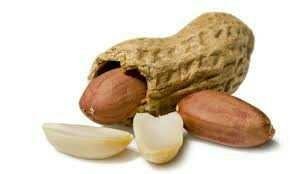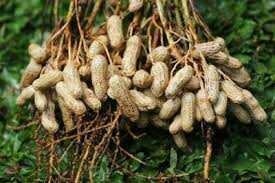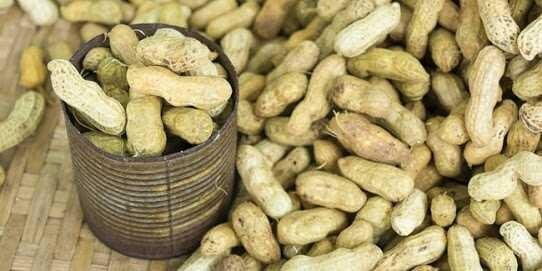Full Explanation of Groundnut Plants
Peanut (Arachis hypogaea L.) is a leguminous crop or abundant member of the cultivated tribe of Fabaceae, and becomes the second most important bean after soybeans in Indonesia. Plants originating from the American continent are grown shrubs as high as 30 to 50 cm (1 to 1½ feet) with small leaves compounded.
This plant is one of two types of cultivated plants other than bogor nut, Voandziea subterranea whose fruit undergoes cooking below the soil surface. If young fruit is exposed to light, the process of seed maturation is impaired.

In Indonesia, he is also known as a unicorn, suuk (Sd), bean jebrol, peanut bandung, tuban nuts, kole beans, and banggala beans. In international trade known as English: peanut, groundnut.
Peanut cultivation many cultivated farmers because the demand for agricultural commodities this one is likely to be stable. Peanut, according to valid data, ranks third in hirearki consumption of legumes in Indonesia after soybeans and green beans. Peanuts are classified into leguminous crops which are quite important especially in Indonesia especially in the context of agriculture. Peanuts have several advantages that benefit farmers. These include peanut plants more resistant to water scarcity or drought, the threat of both relatively fewer pests and diseases, faster harvest of 55 to 60 days, simple planting and management practices, easier post-harvest treatment, fewer failures in total harvests and higher and more stable prices on the market. All these factors make peanut cultivation far more profitable.
Phase of Peanut Growth
Like other legumes, peanut plants are also propagated generatively or through grain. Peanut pods have a cylindrical shape with a length that can reach 6 to 15 cm. Young peanut pods are green. But at the age of mature, the seeds change color to black or brown. In each peanut pod contains 10 to 15 seeds. This grain is then consumed and made into seeds. Here is a picture of the parts of groundnut seeds:
Growth is simply defined as the process of increasing the size of cells or organisms that are more to quantitative or measurable, and irreversible or no longer able to return to its original size. Growth is divided into two categories: primary and secondary. The primary growth itself is the process by which the stem and also the roots increase in length. Primary growth occurs in apical maristam and also growth spots are primary. Whereas secondary growth is a process whereby the activity of secondary or cambium or cambium cancellous cells affects the size of the stem diameter in plants.
Associated with the growth of peanuts, starting from the germination process. This process is the earliest stage of growth of the cultivated plant in the seeds. Germination itself is divided into two divisions namely hypogeal germination and epigeal. Growing on peanuts itself is a hypogeal germination characterized by the occurrence of opposition of the top stem or epicotil and leaves the institution's leaf pulled toward the ground. However, cotyledons remain in the soil.
The process of germination on the growth of green beans occurs in several stages, among others:
Phase 1 where the water enters the seeds or known as imbibisi.Tahap 2 where the embryo is activated to release a hormone called giberelin.Tahap 3 where there is encouragement of aleueron or super thin layer that is on endosperm.This stage 4 is characterized by synthesis of amylase enzyme, maltase and proteases. Step 5 is a phase in which the enzyme prevents food reserves in the endosperm and makes it the energy for growth and energy to form cells. After this stage, usually the stems and leaves begin to appear. Some Factors Affecting Growth
Peanut growth (like other plants) is influenced by several factors. This factor is broadly divided into two parts namely external and internal factors. External factors themselves are the influence from outside that affect the process of growing peanut plants. external factors include water, minerals, air and soil moisture, temperature and light. Meanwhile, internal factors ie things that come from within the plant itself include hormones such as auksin, giberelin, ethylene gas, acetic acid, kalin, and cytokinin. In detail, the hormone kalin consists of rhizokalin which serves to stimulate the formation of roots, kaulokalin which is responsible for stimulating the formation of stems, anthokalin that serves to stimulate the formation of flowers and the last hormone fitokalin in charge of stimulating the formation of leaves.u

In the process of growing peanuts, critical records must be underlined related external factors of light. Light is very important because it acts as energy used for the process of photosynthesis and also plays an important role in the formation of chlorophyll in plants. However, in the germination process, light becomes a potential inhibitor or inhibitor because light can spur auxin diffusion. Therefore, it is important to know, in the process of germination should be done in places that tend to dark.

Benefits of peanuts
Peanuts or in scientific language known as arachis hypogea known by many designations. Some people prefer to call him 'peanuts', just that. Peanuts can now be enjoyed in a variety of dishes, from jam to sambal. In addition to the delicious taste, the benefits of peanuts when consumed also you need to know.
- Lose weight
A study conducted by O'Byrne DJ managed to reveal that eating beans for six months, able to lose weight participants of three kilograms. In this study participants are women who have entered menopause. This condition occurs because there is a decrease in bad cholesterol levels in the body of participants, after a diet by eating foods low in monounsaturated fats are rich in oleic acid content of nuts.
The study was supported by a study conducted by Alper CM who revealed that eating nuts is able to make you feel satisfied thereby reducing your desire to snack snack others. Research by Alper also adds that consuming nuts, making your body absorb 66 percent of the energy contained by nuts but not necessarily raise your weight even though only one kilogram.
In addition, the content of protein and monounsaturated fats owned by nuts, can trigger increase the body's energy release up to 11 percent after consuming nuts for 19 weeks.
- Heart health
Research conducted by Guasch-Ferre concluded that supplementation containing nuts to 7,216 men and women aged 55 to 80 years can reduce your chances of developing cardiovascular disease by 34 percent because of its rich content of magnesium, believed to be able to overcome cancer, heart disease and others that can cause death.
This is supported by a study that adds that eating nuts for 30 weeks, can reduce triglycerides by 24 percent and increase levels of magnesium in the body that can reduce the risk of exposure to cardiovascular disease against your body.
- Bile health
Based on research conducted by Tsai CJ on some participants who recently showed symptoms of gall bladder showed that routinely consume about five ounces of nuts per week, managed to reduce the chances of the participants are attacked by gallstones. Compared to those who consumed less than one ounce for a month, or did not even consume it at all.
Generally, gallstones occur because of the buildup of cholesterol in your bile. But nuts have a content that can control cholesterol levels in the body. This is consistent with a study conducted by Lokko P, which adds that consuming regularly for eight weeks, can lower total cholesterol (7.2 percent) and triglyceride (20 percent) in the body.
Do not eat most
However, as has been done in some studies above, peanuts should be consumed in a certain amount per day. Some literature says that consumption of peanuts with excessive doses precisely in lowering the levels of minerals in your body to increase your risk of kidney failure.
a very good post and very useful for the crowd
Tank you very much
Same same
I am happy to see your post because it is useful for many people
Tank you
Nice post
Tank you